
“Re-Modernologio” Phase1: Contemplationg Society Through Daily
July 23 (Sat) ~ September 19 (Mon), 2011 10:00 - 18:00 / Free
IIDA Ryuta
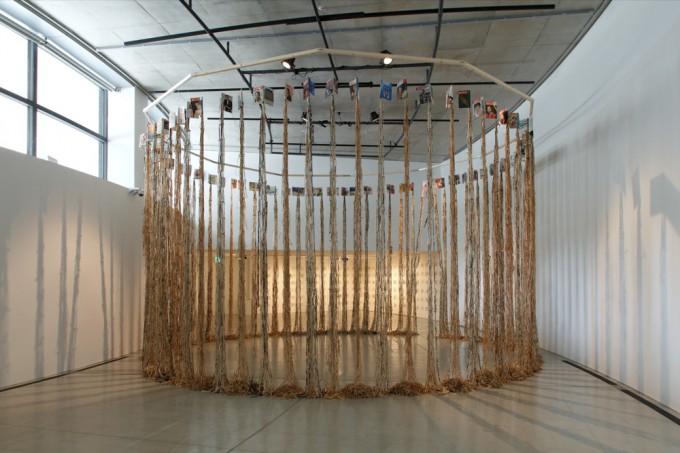
Book like water that flows like waterfall.ーStruggling jointly to a foolish idea is the same as the flow of water.
To Form Structures of a “Book” as an Object and “Reading” as an Action
KONDO Yuki
A “book” is loved by people both as a material object and as a source of stories and ideas but often has a greater influence on them from this immaterial characteristic more than anything else. A book might be similar to a “human being” in that sense.
IIDA Ryuta creates his work using different sources of paper such as books and newspapers as his materials. His sense of form is derived from a kind of sculptural mode of thinking, having focused on sculpture at university. He has invented his unique technique of sculpting with paper by cutting up dozens of sheets of paper and piling them together, transforming them into something new and moving while keeping a fundamental sense of the original material intact . Having felt alienated by the more common materials used by students in the “Department of Sculpture,” such as stone, wood and metal, and the techniques for using them, he found paper to be readily available and a unique and unexpected material. Books also appealed to him because of his respect for their contents and typewritten words, as he is a book lover by nature.
About his choice of materials he remarks, “Every sculptor converts materials such as wood and metal into units which he or she can deal with in order to produce art work. After the decision on units, sculptures can be formed with such units repeated or rearranged. As for me, books were there close at hand as I was searching for which materials were the most suitable for my sculptures.”ⅰ As he says above, he shows an interest in the material structure itself, regarding books as units that can achieve transformation, as well as an interest in the abundance of latent meanings in books. Therefore his art not only refers to the characteristics concerning contents of books, magazines and letters which contain information, infinite nuance and the symbolic world of contents and lines, but also to actions like the opening, turning and closing of pages and the material characteristics of a set of papers on which typing is printed. In this way his art often causes unique and mixed reactions.
In his work “I see, I can’t see” he collected old paperbacks published by Iwanami Shoten and cut off parts of every page. He came up with the idea of cutting and transforming books to put his own personal stamp on them, as it were, because his collection of precious books had often been borrowed by his friends and sometimes never returned, lost. It’s as if he is laying claim to the eternal and sole rights to possess a book that normally anyone can possess by reading. The book has been taken out of its natural circulation as though captured like a specimen of insects. However, the book has been also taken out of its original context, engraving its history and empirical emotions in itself, and then transformed.
The open books are sculpted in such a way as to keep the natural form of the book. In this act of “sculpting a book” he cuts the thin pages one by one and creates a kind of sculptural surface by putting them in a pile. The typing on the visible pages is strangely distorted, overlapped or hidden depending on the methods of cutting and piling the pages, and on the wide range of ways to put different feelings into every book. Even though we cannot interpret what is written in the books, those fluttering fragments of typing on the visible pages have a power to create a different story, different feelings and a different world. Such passages show themselves vividly as they spread around an uneasy sequence of sounds in our minds because we perceive each sound, grasping at each fragment, but unable to guess the completed sentence. Such a book acquires other meanings when its pages are almost pitilessly destroyed and lose all association with the act of reading. This could be why some viewers expressed their embarrassed feelings over his action of “carving a book” while others admired his sophisticated sculpturing techniques. In a material sense, books are just consumption goods that are discarded in large quantities everyday, and if he had used stone, wood or plain paper, no one would have blamed him. That may be because a book bears the strange rights of possession that enable anyone to possess it in an immaterial sense through the action of “reading,” and in addition, because there is some kind of absolute respect for texts representing “human intelligence” inside a book as a medium.
Even so, the work has been produced focusing on a different characteristic of books other than their immaterial characteristic. If he supposes that a sculpture gets formed by an accumulation of actions as “units” and counts “cutting a book” among such units, then it can be said that the work includes the accumulation of innumerable acts of repetition and rearrangement and without emotional regard as to what is being cut away. Thus “consecutiveness and rearrangement” and “repetition” can be perceived as essential elements of his work and are manifested in the form his work takes i.e. a “book.”
The following work gives the appearance of being a paperback, “Turumaki bunko,” published by Turumaki-sha. It’s titled “Oratorical Type” written by IIDA Ryuta, which is a book consisting of 157 pages using nostalgic papers discolored with age, old fashioned font and a printed logo on the front cover with a list of IIDA Ryuta’s past works for advertisement on the last page. The contents are composed of nine chapters from “Oratorical type1” and each page repeats words and phrases like “the process of recognizing a type,” “repetition,” “nucleus of brain and solidification of knowledge,” “impossibility of forming as a book,” “scent of typing” and so on, while rearranging those phrases with punctuation marks and brackets. It seems that such words and phrases are one key to understanding his work and his artistic process, and help us to understand his intellectual processes. Moreover, these words and phrases seem to force the artist to repeatedly question himself and his relationship to them, to continually experiment in rearrangement, and to explore the boundaries between the two facets.
Let us also explore “Verbalized -because I can’t see you-,”ⅱ a catalogue of his solo exhibition held in November 2010. You may suppose that it must contain a large amount of text and many pictures of his work because of the elegant and thick appearance of the catalogue. However, there is something strangely different about the catalogue. Looking at it closely, you will notice that it repeats five times the same part of the catalogue consisting of 32 pages. The typical appearance of the catalogue in the 32 pages notwithstanding, the same part is just repeated innocently like a broken record and the value of information is distorted, thus everything becomes vacant. It may remind you of the works of Andy Warhol. With pictures of scenes of accidents printed repeatedly and roughly, it implies nullification of tragedy and change in quality of information by the mass media. Iida’s works could also show his interest in change in quality by repetition and by differences made in rearrangement.
His interest in the symbolic use of media consumed everyday and the change in quality of information has also shown itself in “Book like water that flows like waterfall.” In this work, 72 old weekly magazines are hanging in groups of six from a dodecagonal wooden frame. Each magazine keeps the front cover as is, but the inside pages are cut to pieces in the shape of an oblong card and suspended from the ceiling, reaching down to the floor, creating a pile of papers. You cannot easily read any of the pages due to their minute width but it’s possible to recognize fragments of words and pictures. It looks as if time is falling down from the magazines hand in hand with discolored papers like the fast streaming news of today. Within the dodecagon, the scent of old paper pervades the air like that of a second-hand bookstore. The information written on the magazines’ pages used to be taken in as the latest and most important news, but now those contents and appearances arouse nothing more than nostalgic feelings and reveal the surfaces without meaning. By being separated into pieces and hung like a flowing waterfall, such magazines that are normally easily consumable begin to show characteristics of a “weekly magazine,” with a distorted value of information and a warped panorama of the times exposed. It seems that separating those elements of a magazine allows more latent and intangible meanings to appear.
In contrast to such magazines dealing with the flowing and passing time of the general public, the work titled “Verbalizes, Because I can’t see you” seems to revolve around memories and the passing of time on a personal level. He uses more private paper media, that is, picture postcards mailed from friends or relatives in specific places while they are traveling. Such a postcard is personal and important only to those who wrote it, those who received it and possibly their personal relations at most, and therefore its owners or readers are restricted. It is both a precious memory and what you should keep to yourself. Many of the words are cut off from the postcards in his work so you cannot read whole sentences, but only guess as to the pictures contained. The meaning of these postcards with holes is made up by others’ memories and imagination, which takes them out of the realm of the personal and into a more generalized realm. This distortion of reality makes the postcards receptive to other nameless individuals’ memories. In addition, Iida organized a workshop to gather participants who brought their own postcards and worked together on the first stage of cutting them up. It seems that the workshop offered the chance to cut the postcards containing more personal memories while retaining original personalities, that is to say, to make them nameless in a sense while retaining the personality.
Thus, in Iida’s work, the meanings of materials often has a great influence on the work itself, on the artist and on the viewers, while his method of creation supplies the structural form that guides the process. Could this be because the materials themselves are the result of highly civilized human intelligence i.e. paper media, different from natural materials such as wood and metal, and also different from primitive materials? The artist himself doesn’t place much stress on the meanings but instead bases his works on “paper media” as an object and on its structure and system, and therefore sets one sphere against another, keeping a sensitive balance between both meaning-driven and form-driven work.
References
ⅰHATTORI, Takayasu. (2007).‘Capter5: The Gift, IIDA Ryuta, Accompanying the original envelope created from a “book” with pictures and words’ in THE BOOK OF PHOTO COMMUNICATION. Shoeisha Co., Ltd. P79.
ⅱIIDA, Ryuta. (2010). Verbalized –because I can’t see you–. Tokyo: Takuro Someya Contemporary Art.
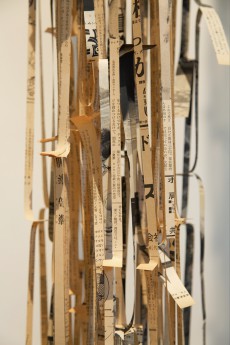
Book like water that flows like waterfall.ーStruggling jointly to a foolish idea is the same as the flow of water.(detail)
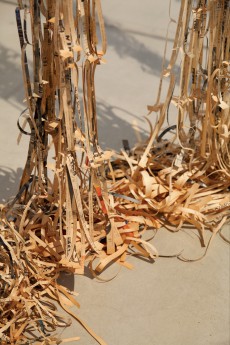
Book like water that flows like waterfall.ーStruggling jointly to a foolish idea is the same as the flow of water.(detail)
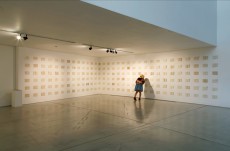
I see, I can't see.

I see, I can't see.

I see, I can't see.
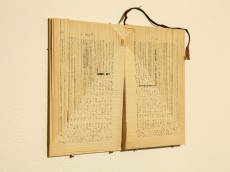
I see, I can't see.
「再考現学 / Re-Modernologio」 phase1 : 衣食住から社会をまなざす
2011年7月23日(土)~ 9月19日(月)10:00 - 18:00/無料
飯田竜太
IIDA Ryuta

《Book like water that flows like waterfall.ー水は低きに流れ、思考もまた低きに流れるー》
物質としての「本」あるいは行為としての「読む」の構造を造形する
近藤由紀
「本」ほどその非物質的特性と物質的特性の両方が人々に愛され、しばしばその非物質的特性が強い影響を与える物体はないのではないか。その意味で本は「人間」に似ているのかもしれない。
飯田竜太は本や新聞といった紙を素材として作品を制作してきたが、彫刻を修めた飯田にとって、その造形の意識は彫刻的な思考から発している。紙を一枚一枚を 切り重ね、造形するその技は、それらをその素材感を残したまま驚くべき姿に変貌させる。いわゆる「彫刻科」で選択するような石や木や鉄といった素材や手法に対する疑問から身近な紙を素材として選択したが、もともと「本」好きであった飯田はその本の中身や文字に関心を持つようになったという。
一方で「あらゆる彫刻家は、木や鉄などの素材を自分が扱える単位に置き換えて作品を作ります。単位が決まればその連続性や組換えで彫刻は成立するのです。自分の場合、どうしたら彫刻が成立するのか、その素材を考えていた時に、身近にあったものが本でした」[i]と 飯田がいう場合、そこには本という素材がもつ豊かな潜在的な意味性に対する関心のみならず、本を造形を成す一単位と捉え、その構造に関心を寄せているのがわかる。したがって飯田の作品には、その内容や行間から情報のみならず無限のニュアンスと象徴世界を繰り出す本や雑誌や手紙の中味に関する特性のみならず、開き、めくられ、閉じられるという運動性、そして文字が印刷された紙の集合体という物質的な特性への言及もみられる。一方でそれゆえにしばしばその作品は独特な反応を引き起こす。
≪I see, I can’t see—目に見える、見えない—≫は、飯田が収集した岩波の古い文庫本に切り込みを入れた作品である。飯田は自分が収集していた貴重本がし ばしば借りられたまま返却されずに失われたことをきっかけに、読んだ時間、内容を自分のものとして完結させるために、本を切って開くことを思いついたのだという。その感覚は、読むことで不特定多数の所有となりうる本を、昆虫採集の標本のようにその流れから切り離し、自らの完全なる所有にすることにも似てい る。だが一方で本来の文脈から切り離された本は、本にまつわるあらゆる時間と経験的感覚をその内に閉じ込め、変容する。
開かれた本は、本としての自然な形態を保ったまま彫刻されている。「本を彫刻する」こと、すなわちそれは一枚一枚の薄い紙に切り込みを入れ、その重なりによってある表面を作り出すことであり、切り込まれ方とページの重なり方によって、展示された見開きのページの文字は奇妙に歪み、重なり、消失しており、その多様な方法によって、それぞれの本がそれぞれの表情をみせている。何が書かれているかは読むことが出来なくても、その見開きページに並ぶ踊るような文字の断片には、どこかしら別の物語を、別の感情を、別の世界を紡ぎだしうる力がある。それがより生々しく感じられるのは、一文字一文字は何であるか推測できるため、その音のようなものは追えるが、文章として成立しないがために、瓦解した文章が不穏な音の連鎖を意識の中にばらまくからであろうか。作品は読むということから解放さ れた内側を痛々しく晒すことで、別の行間を獲得する。そのためであろうか、その彫刻の繊細な技への感嘆が聞かれる一方で、「本を刻む」という行為に対し、 少なからず複雑な心情を吐露する鑑賞者もいた。それらは物としては日々大量に処分される消耗品であり、例えば石や木や単なる紙に対してはそのような批判が おきないというのに。そのことは本という物質が「読む」という行為を通して非物理的な意味で誰のものにでもなりうるという不思議な所有権が発生することと、本という媒体に含まれる「人間の叡智」としてのテキストに対する不可侵の敬意のようなものが存在するからではないだろうか。
だが一方で この作品は、こうした本の非物質的な特性にのみ焦点をあてて制作された作品ではないだろう。飯田が作品を一つの単位として捉えられた行為の積み重ねによって成立すると考え、「本を切り抜く」行為をその一単位として捉えているとするならば、ここにあるのは無数の繰り返しとその置き換えの集積であるということもできる。飯田の刻む行為にはある種の感情が託されるようなところはみられない。そして飯田の作品にとってこの「連続性と置き換え」、「繰り返し」は、それ自体が重要な要素であり、それは飯田の作品として「本」によくあらわれている。
蔓巻社(社は旧漢字が使われている)なる出版社の「蔓巻文 庫」の体裁をとった作品がある。飯田竜太著『雄弁なる文字』というこの作品は、時代を感じさせる退色した紙と古い種類のフォント(おそらく わざと)が使われ、ロゴが印刷され、最終頁には宣伝のための著者「飯田竜太」の過去作品一覧や奥付まである157頁からなる文庫本である。その中身は 「Oratorical type1」から9の章立てからなっており、1頁毎に「文字だと認識する過程」「繰り返し」「脳の中格子、知識の固定」「本としての成立を不可能にする」 「文字が持つにおい」などといった単語や文章の一センテンスが句読点やカッコなど体裁を組み替えられながら反復されている。それらは飯田の作品や制作についてのキーワードであり、思考のプロセスのようでもある。それは繰り返される疑問であり、組換えによる実験であり、その探求のようでもあ る。
またここに2010年11月に開催された飯田の個展カタログ『Verbalizes 出会えないから、言葉で』[ii]が ある。立派な分厚いカタログでさぞかし沢山の評論と作品写真が掲載されているのだろうと思ってページを繰ると、様子がおかしい。よくみるとそれは32頁のカタログ部分が5回繰り返して収録されているのである。32頁分は通常のカタログの体裁をとっているにも関わらず、壊れたレコードのように同じ部分が何食わぬ顔をして繰り返されるだけで、その情報としての価値が変質し、あらゆるものが空虚になっていく。アンディ・ウォーホルは事故現場の写真を繰り返し粗く 印刷したものを提示することによって、悲惨さの無化とマスメディアによる情報の変質を示唆したが、飯田の作品からも繰り返しによる変質、置き換えが生む差 異による変質に対する関心がうかがえる。
日々消費されていく媒体の象徴的利用、変質していく情報への関心は≪Book like water that flows like waterfall.―水は低きに流れ、思考もまた低きに流れる―≫にもみられる。この作品では12角形の枠に6冊ずつ計72冊の古い週刊誌が吊り下げられている。それぞれの雑誌は表紙をそのままに残したまま、中身が短冊状に刻まれ、天上から吊り下げられ、床に到達した紙片が山を築いている。紙面は短冊の幅が狭いため文章としては読むことはできないが、単語や写真の断片を認識することはでき、色あせた紙とあいまって、早送りで流れるニュース映像のように時間が週刊誌からこぼれ落ちているようにもみえる。12角形の中に入ると古本屋の店内のように、古い紙の匂いが充満する。当時はそこに書かれている情報があたかも最新で最重要な情報であるかのように摂取されていた週刊誌は、今となってはもはや内容も外形もノスタルジックな感情しか呼び起こさず、その中心なき 表層性を強調する。ばらばらに解体され、流れる滝のように吊り下げられた大量に消費された雑誌は、「雑誌」の持っている要素を解体することで、隠し持っていた無形の意味を有形化させるように、「週刊誌」という雑誌の特質、情報の価値、時代の流れを目の前に提示する。
雑誌が不特定多数の流れ消 えゆく時間を対象にしていたのに対し、≪Verbalizes, Because I can’t see you―出会えないから言葉で―≫では、個人の記憶や消えゆく時間を扱っているように思われる。ここではより私的な利用がなされる紙媒体――旅先からの絵葉書――が使われている。送られた絵葉書はそれを書いた人物と受け取った人(広げても個人的に関係のある人)にしかその価値はなく、個人的であるがゆえに その所有者/読者も限定される。それは大切な思い出であると同時に、秘められるべき存在ともなりうる。作品における絵葉書の文字はほとんどがくりぬかれ、 文章を読むことはできないが、絵や写真は大体の見当をつけることはできる。穴のあいた絵葉書は、記憶や想像の中で補完され、完全体を想像されることで個人に属することをやめ、切り抜かれた穴をもつことで再び別の匿名化された個々の記憶を受容する。飯田はさらにこれをワークショップという形で参加者を募り、 絵葉書の提供を受け、切り抜きの初段階の作業を共に行った。それはより多くの個別の記憶を宿す絵葉書をそれぞれの個性が反映されるような仕方でくりぬくこと、すなわち個性を残しながら匿名化することであったようにも思われた。
このように飯田の作品においてその制作の方法は構造的に捉えられながら、しばしばその素材のもつ意味性が強い影響を作品と作者そして鑑賞者に与えている。それはそれらが高度な人類の知の産物であり、木や鉄と異なり自然物でもなければ、原始的な素材でない紙媒体を扱っているからにほかならない。だが飯田はその意味性を強調するのではなく、あくまで物としての「紙媒体」とそれが有する構造やシステムを制作の根幹とすることで、両者の特性の微妙なバランスの中で両者の領域を際立たせていく。
[i] 『写真以上、写真未満』、「第五章 贈る 飯田竜太さん 『本』から生まれるオリジナル封筒に写真と言葉を添えて」(取材・文・撮影/服部貴康)、翔泳社、2007年、79頁。
[ii] 飯田竜太「Verbalizes—出会えないから、言葉で—」2010年11月6日~12月4日、Takuro Someya Contemporary Art, Tokyo.

《Book like water that flows like waterfall.ー水は低きに流れ、思考もまた低きに流れるー》

《Book like water that flows like waterfall.ー水は低きに流れ、思考もまた低きに流れるー》

《I see, I can't see.ー目に見える、見えない》

《I see, I can't see.ー目に見える、見えない》

《I see, I can't see.ー目に見える、見えない》

《I see, I can't see.ー目に見える、見えない》
